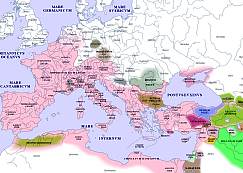 Virtual Catalog of Roman Coins
Virtual Catalog of Roman Coins Virtual Catalog of Roman Coins
Virtual Catalog of Roman Coins

An Online Encyclopedia of Roman Emperors
Galba (68-69 A.D.)
David J. Coffta
Canisius College
The rebellion of Gaius Iulius Vindex, governor of Gallia Lugdunensis, in March 68 A.D. marked the beginning of the end not only for Nero but also for the Julio-Claudian dynasty and its principles of accession. Galba, the only local provincial governor to side with Vindex (though he did not provide him with troops), had enjoyed the favor of earlier emperors and a distinguished career (consul in 33, proconsul in Africa in 45, and governor of Hispania Tarraconensis from 60 to the rebellion in 68). The specific motivation for Galba's opposition to Nero, or Vindex's for that matter, remains unclear, though both men may have intercepted letters from Nero to their subordinates which had ordered their own elimination.
The defeat of Vindex by Lucius Verginius Rufus at Vesontio later that year did not end Galba's chance at the throne, for the rebellion had created at Rome an opportunity for Gaius Nymphidius Sabinus (appointed praefectus praetorio in 65) to turn the imperial guard against the emperor with the promise of a reward for allegiance to Galba. Deposed by the Senate and abandoned by his former supporters, Nero committed suicide in June 68. Accompanied by Otho, governor of Lusitania, Galba marched toward Rome, having abandoned the title of legate and adopted that of Caesar; he arrived in October 68 to begin his reign.
The traditional depiction of Galba emphasizes his reluctance to spend freely, a trait which won him no friends among any of the people whose support he needed to remain in power, though not a critical flaw. His truly grave error, however, was to be parsimonious with the soldiers. At Rome he denied the praetorians their reward, and in the provinces the soldiers in Upper Germany, who had fought against Vindex, complained that they had yet to be rewarded--an odd demand given Galba's earlier association with Vindex, perhaps intended as a reminder to Galba that loyalties could change.
On 1 January 69 A.D. the troops in Upper Germany refused to declare allegiance to Galba and instead followed the men stationed in Lower Germany in the proclamation of their commander, Aulus Vitellius, as the new ruler. In response, Galba adopted Lucius Calpurnius Piso Frugi Licinianus, at the instigation of questionable advisors and with the approval of the Senate, in an attempt to demonstrate that his successor was not to be chosen for him. This decision meant little to the remote armies and incurred at Rome the resentment of Otho who had hoped to succeed Galba. Otho organized a conspiracy among the praetorians, with a now-familiar promise of material reward, and on 15 January 69 A.D. they declared him their emperor and publicly killed Galba; the death of Piso followed at once.
Galba's brief reign is significant because he was neither related to nor adopted by his predecessor Nero. The events which led to his accession set precedents (declaration by one's troops abroad) and also recalled earlier intrigue among the praetorians at Rome under the Julio-Claudians; the combination advanced Galba at first but came back to haunt him in the end.
Cary, M., A History of Rome down to the Reign of Constantine, London ,1962, 596-599.
Grant, M., History of Rome, New York, 1978, 285-6.
Momigliano, A. "Galba 1."OCD,2 376-377.
Tacitus, Histories; Suetonius, Galba; Plutarch, Galba; Dio Cassius, Roman History, Books 63-64, Josephus, Jewish War, 54.
Bowman, Alan K., Edward Champlin, Andrew Lintott.The Cambridge Ancient History X; The Augustan Empire.2 Cambridge, 1996.
Murison, C.L. Galla, Otho, and Vitellius: Careers and Controversies. New York, 1993.
Sherk, R.K. The Roman Empire: Augustus to Hadrian. Cambridge, 1988.
Shotter, D. Suetonius: The Lives of Galba, Otho, and Vitellius with Translation and Commentary. Warminster, 1993.
Sutherland, C.H.V. Roman Imperial Coinage. vol. 1 London, 1984.
Comments to: David J. Coffta
Updated: 12 September 1996
For more detailed geographical information, please use the DIR/ORBAntique and Medieval Atlas below. Click on the appropriate part of the map below to access large area maps.
